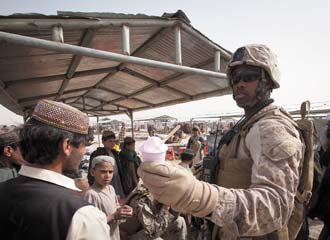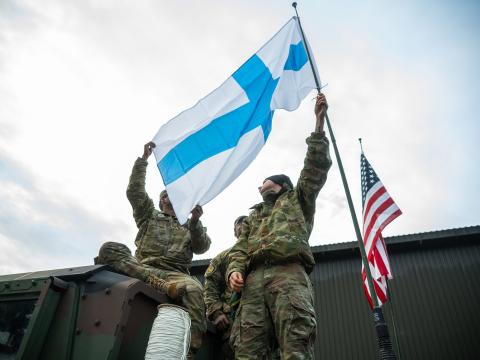Marines Network in Southwest Afghanistan
 |
Sgt. Thomas Brown, USMC, a squad leader with Golf Company, 2nd Battalion, 3rd Marine Regiment, buys ice cream for his squad during a patrol of Khalaj Bazaar, Garmsir District, Helmand Province, Afghanistan, during "Bazaar Friday." On Fridays, Khalaj Bazaar draws an average of about 3,000 villagers who gather to buy and sell livestock, meat, poultry, textiles and various wares. The bazaar draws traders from as far as Herat Province, in western Afghanistan. |
During a year spent in the harsh environs of Helmand Province, communications Marines from the 1st Marine Expeditionary Force (Forward) engaged in a range of projects that helped protect their fellow warfighters and changed the face of technology in the area. From enlarging existing networks to introducing capabilities new to the Corps, systems in that territory will never be the same. And neither will the lives of the local residents, who are taking advantage of the increased stability in the region.
Both danger and violence are inherent in the province, where troops face an incredibly kinetic fight. More than 150 Marines have lost their lives in the area since operation Enduring Freedom began. The end of 2010 and beginning of 2011 were particularly brutal as troops ramped up operations against Taliban strongholds in the region. However, Marines say coverage of those topics misses a large part of the area’s story. Capt. Russell Cromley, USMC, network operations and systems officer at Camp Leatherneck, explains, “All of us here have seen the fruits of our labor. You see more children in schools; the reopening of bazaars and markets; stability in the local government; increased security; and most importantly, economic growth for the people of Afghanistan.”
The captain felt safe enough to go to market areas himself wearing no protective gear—although other troops in the area had weapons—and local people were comfortable conducting business with him. “I don’t think you could have done that two years ago in Helmand Province,” he says, adding that such events are proof that U.S. and coalition casualties there are not in vain: The efforts of the troops are securing people back home and bringing new opportunities to the Afghan people. The captain sums up the progress, stating, “Make no doubt about it, we’re winning this war ... we see what’s happening here, and it’s all positive.”
Efforts by 1st Marine Expeditionary Force (I MEF) communicators contributed to the successes. Capt. Cromley talks about what his team did, explaining, “We don’t really use the ISR [intelligence, surveillance and reconnaissance] equipment. We enable everyone to use it. We make sure it’s available. We protect it. We engineer and design how that stuff will interact [with] or operate on our network. We’re more like facilitators between operators and end users. So we kind of provide the end-to-end service between the ISR and the actual user.”
One of the technologies they employed to enable communications was Riverbed Technology’s Steelhead, an Internet protocol acceleration and compression device. It uses a wide area network (WAN) optimization device that performs data and latency reduction along with transmission control protocol acceleration. 1st Lt. Justin Norman, USMC, assistant network operations and systems officer, says the capability’s importance cannot be overstated, especially on the unclassified network where users leverage it most often. “The reason I say that is that we have limited strategic bandwidth,” he explains. “We share with whoever else happens to be on the satellite at that time.”
The Steelhead can strip off unnecessary components in the data, compress it into smaller pieces and transport it more quickly to the receiver. With the technology, the Marines estimate they had about triple the physical bandwidth and throughput as before. “I don’t think the number of users we have would be supportable without such technology,” Lt. Norman explains. “That technology really has been invaluable.”
Before the expeditionary force began its work with the optimization tool, the unit previously occupying their area of operations—Marine Expeditionary Brigade Afghanistan—ordered the devices and put them in place on the other side of the satellite link. When the MEF arrived in theater, communications personnel figured out how to make them work.
The types of devices purchased is the limiting factor on the bandwidth enhancement. With more expensive versions, Capt. Cromley projects, bandwidth availability could swell to five, six or even 20 times as much. Eventually, the Marines hope to see upgrades to the Steelheads as well as to see them installed on links between forward operating bases (FOBs). Extra bandwidth would eliminate some of the limitations on the persistent video feeds to warfighters on the ground.
Capt. Cromley continues that these links are the only ones connecting units in the field to strategic tactical entry points, increasing the bandwidth available to those points. With the WAN optimizers, bandwidth availability goes up while the amount of real traffic over the satellite link remains consistent. This saves money as well. The captain says that on a satellite link using the optimizer, he could access several times as much bandwidth while paying for only half.
All the communications Marines agree that bandwidth is always in short supply. “There’s never enough to the outside world and never enough between FOBs and command posts,” Capt. Cromley says. The Marines believe industry could help with the challenge by taking bandwidth utilization and traffic on a tactical network into account when working on programs of record.
 |
Capt. Kevin P. Newport, USMC, detachment commander with Personal Security Detachment, Battalion Landing Team 3/8, 26th Marine Expeditionary Unit, Regimental Combat Team 2, ground guides a Mine Resistant Ambush Protected vehicle prior to departing on a convoy from Camp Leatherneck. Communications Marines with the 1st Marine Expeditionary Force (Forward) stationed at Camp Leatherneck for a year put in place several new technologies that enhance operations in the region. |
The troops also had other items on their wish lists, including more high-speed, low-latency connections and convergence routing.
Gunnery Sgt. John Baker, USMC, data engineering chief with the I MEF, shares a different type of capability he would have liked: “Really, the newest versions of all the software are key.” Each update includes improvements that help prevent downtime and make the network more stable. “That’s really what we want—just a more stable network,” Gunnery Sgt. Baker explains. Improvements also make software easier to administer. “Being able to actually use the newest software could alleviate a lot of bugs on our networks that we can’t get rid of until Microsoft comes out with new versions and [we] upgrade to the new version,” he says. “Sometimes it’s difficult to get upgraded to the newest version when you’re out here.”
Lt. Norman agrees with the gunnery sergeant, adding that upgrades to the software and other capabilities help with administration of the entire enterprise. This includes not only small and forward units but also large groups that require delivery of uninterrupted services at a high level to thousands of users. “Once you get to that sort of level, there are certain versions, levels and degrees of software, and sometimes hardware as well, that actually don’t support communications [for that many people],” the lieutenant says.
Other items the Marines could have used in the field involve more ways industry, and even the government, can support those deployed. Gunnery Sgt. Alonzo Lawton, USMC, the unit’s information assurance (IA) manager, says that once network technologies arrived in theater and went online, his mission was to ensure security so no one could penetrate, log in or take information from the network and its pieces. “My wish list is that this gear comes with those settings already set in configuration before it arrives in theater,” he says. “Because once it comes out here and it gets to our Marines who are actually operating at these lower levels, they’re not mindful to set those settings up so that information is protected.” IA personnel in the Marine Corps try to configure devices so they remain secure and provide uninterrupted services. “I think that should be tested at a level above us before that gear gets here and also built in ... so once you put it online you already know it’s secure and that all the communications and data flowing over the device are secure as well,” he adds.
Though Marines with the I MEF lacked some capabilities they desired, they made the best of what they had, to the point of implementing standards new to the Corps and the theater. Capt. Cromley explains that, “We are the first fight in all of Afghanistan to be completely virtualized.” While installing the VMWare created some complications, such as bumps with linking to certain stations without full virtualization, the change was a success overall. It increased server availability as well as eased administration. When users experienced problems on the servers, the virtualization tools migrated hosts to a functioning server, and customers never even realized a problem had occurred.
Also successful during the deployment were the PRC-117G radios, which enable computer networks to extend to any individual user. Capt. Cromley explains that before Marines fielded the devices, forward deployed warfighters would make several attempts over voice communications when calling for fire before information was received accurately. With the 117Gs, personnel can use a chat program to type in the pertinent facts, knowing it copies correctly the first time. The result is a drop in support time from minutes to only seconds—a major difference to those under attack. “We helped engineer that design,” Capt. Cromley says, “and there’s a success story afterward where our people have tactical communications where they couldn’t have them before. It’s a really good thing for us.”
Technical achievement is only a small part of the triumph. All the communications Marines at Camp Leatherneck were cognizant during their tour that their actions affected lives in a region fraught with danger for warfighters. Gunnery Sgt. Lawton explains that when he deployed security settings on capabilities such as the 117G, he remained mindful that certain measures could affect the capabilities of forward Marines to program or configure their radios. His biggest challenge involved balancing operational requirements with the intent of military and Marine Corps IA standards. By working with his leadership, he developed ways to apply necessary settings without shutting off services to Marines downrange.
Ensuring effective information exchange is the job of communications Marines, and in many cases, the job becomes personal. Lt. Norman elucidates the situation, saying, “I have a lot of peers who operate at the platoon level. That’s about the level where lieutenants typically are and have influence. One of the things they talk the most [about is] ... communications posture—what they are able to do and what they are not able to do. Sometimes they’re frustrated. Sometimes they’re happy, but it really, really keeps my focus and priorities straight.”
When he sees his fellow young officers, he understands the direct impact his work has in the field. “Those are my peers,” Lt. Norman says. “Those are people I went to school with. Those are people I know personally who are affected by this. While we might not see it at our particular location, we really have to be careful to maintain that single focus on what it is we’re doing. Because the real impact is human life.”
Gunnery Sgt. Baker adds to the lieutenant’s explanation that communicators in theater need to understand they are not playing in an exercise where a glitch means someone in garrison loses e-mail for an hour. “Literally, people’s lives hang on these networks out here,” he emphasizes.
WEB RESOURCES
1st Marine Expeditionary Force: www.i-mef.usmc.mil
Regional Command Southwest News: http://regionalcommandsouthwest.wordpress.com
Riverbed Technology Steelhead Products: www.riverbed.com/us/products/steelhead_appliance/index.php




Comments